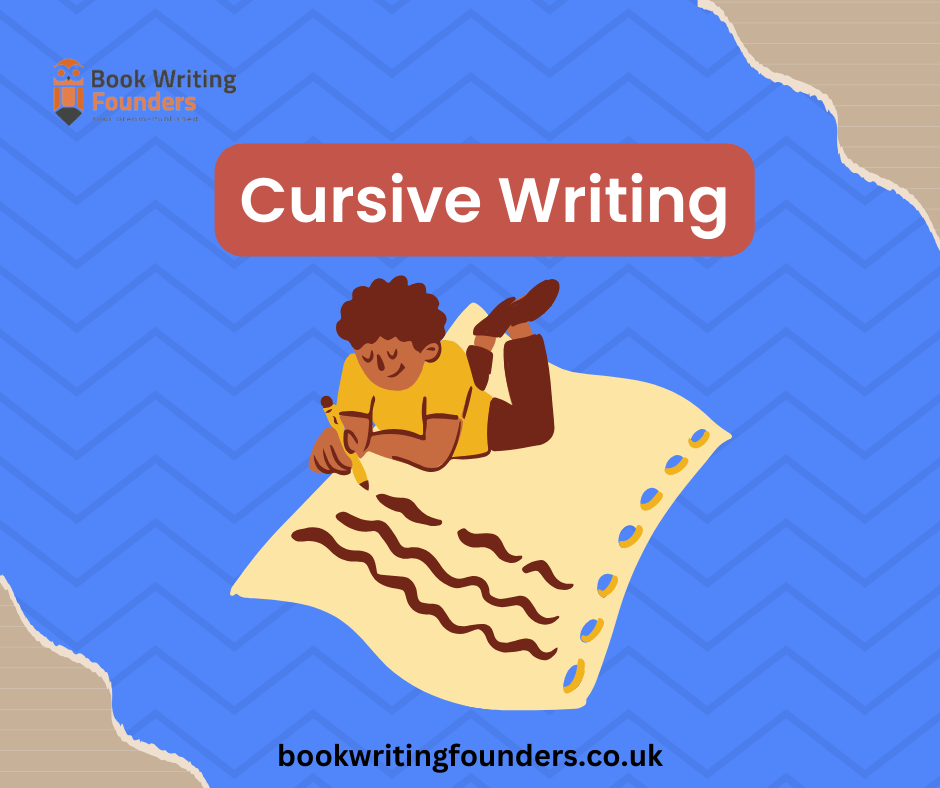
Writing
Introduction
Cursive writing is a style of handwriting where all the letters in a word are joined, giving the penmanship a flowing, often elegant, appearance. One can trace its origins back to Roman times. At its core, this writing is a skill blending aesthetics and efficiency – it helps write faster and adds a visual appeal to the written text. Learning cursive involves more than just mastering elegant letters. It enhances cognitive abilities and academic performance, contributing to children’s mental and intellectual development.
Our Manuscript Writing Guide offers step-by-step instructions on writing in cursive and provides insightful tips to make learning more enjoyable and rewarding.
What is Cursive Writing?
Cursive writing is a unique style of penmanship primarily characterized by handwriting, where letters are often connected in a flowing manner. ‘Cursive’ is derived from the Latin’ cursivus,’ meaning ‘flowing’ or ‘running.’ This alludes to the pen’s flowing and continuous movement while writing cursive.
When learning cursive, consider letter positioning and shape as key elements. Each letter has its designated line, forming a joint writing style prevalent throughout history. Cursive, valued by professors, enhances writing prowess.
Master sloping letters starting from the base and ending with a stroke at the upper baseline. Some letters feature loops at the top or bottom, varying by letter.
Background of Cursive Writing
Now, let’s talk about a little of its history. The origins of cursive writing date back to the times of ancient civilizations. The Romans were among the first societies to use this writing style, developing it as a way to write faster and more efficiently. This swift writing style was valuable, enabling scribes to capture live speeches and facilitating maintaining records more quickly.
But it took off during the Renaissance, with the advent of the writing method known as “Italic Handwriting.” Named after Italy, its place of origin, Italic Handwriting is a semi-cursive writing style characterized by curved and flowing letters, which were easier to write and more aesthetic.
By the 18th and 19th centuries, this writing style became commonly taught in schools worldwide. Modifications and developments led to different styles of cursive writing, influenced by specific geographical regions like English Roundhand and Spencerian Script in America.
Learning Cursive Writing: Take it Step by Step!
Learning to write in cursive can be super fun and rewarding. It’s like drawing and writing all mixed up together. Here’s a step-by-step guide that’ll have you writing cursive like a pro in no time.
Step 1: Understand the Cursive Alphabet
Okay, so each cursive letter is a bit like a little drawing. Some are like loops, and others have tails. Knowing what each letter should look like is your first big step. And watch out for the ‘entry strokes’ and ‘exit strokes’ – they’re like ramps to help letters join up and dance across the page together.
Step 2: Master Individual Letters
Now, let’s buckle down and draw – I mean, write these letters! Grab some lined paper (those lines are like training wheels), and start with the easiest lower-case ones like ‘c,’ ‘l,’ ‘a,’ ‘d,’ ‘g,’ and ‘o.’ They’re mostly all about the loop-de-loops. After you’ve got the easy dudes down, step up to the tricky gang like ‘b,’ ‘f,’ ‘k,’ ‘p,’ and ‘z.’
Step 3: Practice Capital Letters
Capital letters in cursive can look super fancy, like kings and queens of the alphabet. They’re a bit tougher than the lower-case crew, so tackle them with patience. Like before, stick with it until you feel you’ve befriended each of these capital letter royals.
Step 4: Joining Letters
Linking the letters together is what makes cursive, well, cursive! Practice sliding from one letter to the next without picking up your pen. It’s like they’re holding hands.
Then, It’s combining letters time! Start small with easy words. Once you’re good at those, throw in some longer ones. It’s like building with blocks – start with a small tower before you build the castle.
Step 6: Practice with Sentences
Got the hang of individual words? Excellent! Now, it’s time to connect them into sentences. This is where all your learning truly comes to life. Keep that pen flowing, connecting your thoughts and your paper seamlessly.
As with any skill, mastering cursive writing requires a dedicated commitment. Establish a writing routine where you put aside at least 20 minutes each day to focus on the cursive alphabet—start with lowercase letters before progressing to uppercase ones. Writing essay drafts in cursive enhances skill and familiarity. Later, type them into a Word document for ease and practice.
The more you write, the more your hand remembers, and the better you get. It’s like playing a game – the more you play, the higher your score.
Is There an Order For Teaching Cursive Writing?
Teaching cursive doesn’t follow a strict order, but experts suggest starting with lowercase letters before uppercase ones.
Children typically begin learning cursive around age seven, progressing independently by age nine. The recommended order for learning cursive letters includes:
– c, a, d, g, q
– i, t, p, u, w, j
– e, l, f, h
– k, r, s
– b, o, v
– m, n, y, x, z
This sequence, backed by research, introduces simpler letters first, resembling their print counterparts and aiding in joining words efficiently. Progression to more complex letters occurs as children master initial ones through consistent practice.
Why People Write in Cursive
Cursive writing is gradually regaining popularity, with handwriting enthusiasts and educational institutions advocating its benefits. Here are a few reasons why people choose to write in cursive:
Speed and Efficiency:
Writing in cursive is significantly faster than print handwriting. The continuous flow of cursive handwriting increases writing speed, promoting efficiency.
Intellectual Development:
Research suggests that learning cursive can enhance intellectual development in children. It helps refine motor skills, improves literacy levels, facilitates memory recall, and promotes the development of cognitive skills.
Aesthetic Appeal:
Cursive handwriting offers a unique aesthetic appeal that adds personal charm to any written piece. Its fluidity makes it ideal for ceremonial documents and calligraphy. Furthermore, the role of cover design typesetting enhances this visual charm in print documents, creating a polished look.
Individuality:
In addition to its functional and cognitive benefits, this writing style is unique to each writer. How one connects and forms letters is typically individual, fostering self-expression and providing a sense of identity through penmanship.
Tips To Write Well in Cursive
Writing in Cursive is a beautiful art form, though it may seem daunting initially. Here are some practical tips to improve your cursive writing skills:
Understand the Cursive Alphabet:
To write well in cursive, first familiarize yourself with the cursive alphabet. Note the nuances for each letter in the cursive script — both lowercase and uppercase.
Use the Right Tools:
A good quality pen or pencil and lined paper can greatly impact how you learn this writing style. A pen running smoothly over the paper will make writing much easier.
Start with Lowercase Letters:
Lowercase letters are simpler and more frequently used in this style of writing. Practice them consistently until you’re comfortable, then graduate to uppercase letters.
Consistent Practice:
Like any other skill, practice makes perfect. Develop a habit of writing in cursive daily. This consistency will help you retain the unique strokes of cursive.
Master the Connections:
The cursive style of writing is all about the flow. Spend ample time mastering connecting one letter to another, creating an uninterrupted line of text.
Maintain a Steady Pace:
Keep your speed slow and consistent while learning. Trying to write quickly may make your letterforms sloppy. As you become more comfortable with cursive writing, gradually increase your speed while maintaining legibility.
Posture and Grip Matter:
A comfortable sitting posture and a relaxed yet firm grip on the pen can help you write better and for longer periods.
Experiment with Styles:
Over time, you can experiment with cursive variations to develop your unique style. Remember, your handwriting is a reflection of your individuality.
Should You Teach Cursive Writing?
Teaching cursive writing offers numerous benefits, making it a valuable skill for children. Beautiful cursive enhances neatness and writing speed, which is crucial for jotting down lecture notes efficiently.
Cursive fosters motor skills, pen control, and letter recognition while refining manual dexterity and hand-eye coordination. Introducing cursive early facilitates easier skill absorption, aiding overall education.
Cursive isn’t limited to English; it’s a tool across disciplines. Encouraging cursive empowers children to express themselves uniquely, fostering individual handwriting styles. Embrace the art of cursive for its practicality and personal touch in communication and self-expression.
When considering all the enriching benefits of learning cursive, it’s also worth noting that these skills extend beyond education settings. Partnering with a Business Book Writing can bring that vision to life for those looking to further reinforce this skill, or perhaps even publish their cursive practice materials. Such services can assist in creating customized practice books to preserve the art of cursive writing.
Conclusion:
Cursive writing is integral to human culture and history with varied practical, intellectual, and aesthetic benefits. While technology continues to evolve and mechanical typing replaces handwriting, nothing can beat the charm, individuality, and personal touch of a well-scripted cursive note.
Becoming proficient in cursive involves more than mastering strokes and connections—it promotes cognitive growth and fosters a feeling of artistic individuality.
Though technology’s impact is immense, particularly with tools like AI writing generators for creating custom learning resources, the significance of cursive doesn’t dwindle. Using AI for studying cursive can be an advantage, but the essence of the skill lies in personal dedication and practice.





